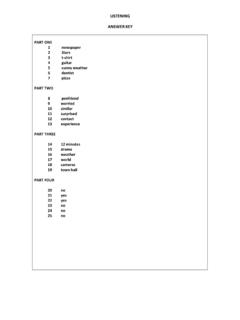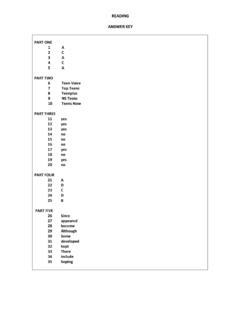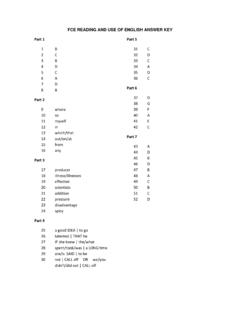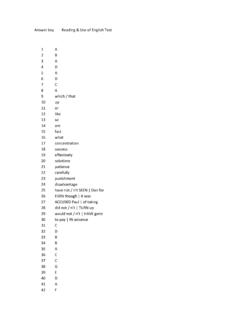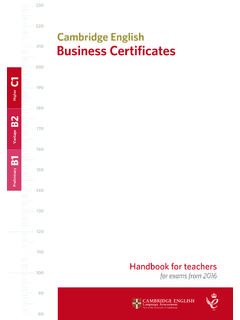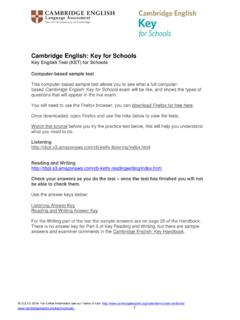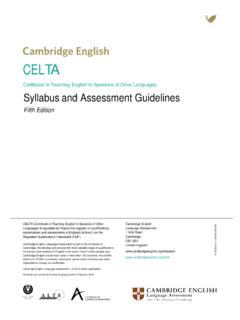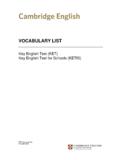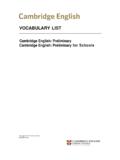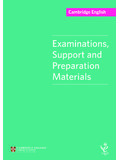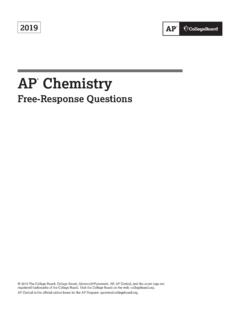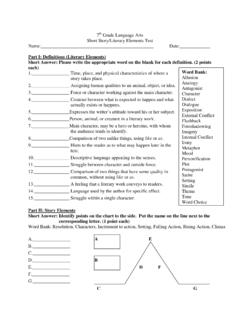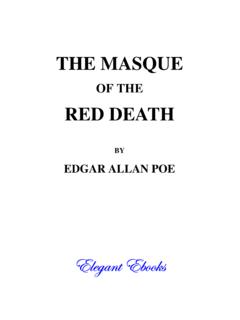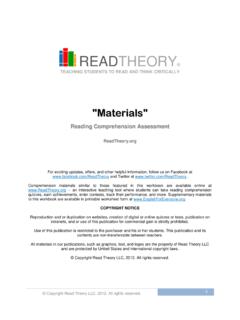Transcription of Cambridge English: Proficiency (CPE)
1 Cambridge English: Proficiency (CPE) Frequently Asked Questions (FAQs)Is there a wordlist for Cambridge English: Proficiency exams?No. Examinations that are at CEFR Level B2 (independent user), or above such as Cambridge English: Proficiency do not have particular language specifications or vocabulary I have to pass each paper in order to pass the whole examination?No. Your overall performance is calculated by averaging the scores you achieve in Reading, Writing, Listening, Speaking and Use of English. The weighting of each of the four skills and Use of English is and Use of EnglishDOP Read the instructions, texts and questions very Work through the parts of the paper in the order that suits you Read the sources, titles and subtitles of the texts where given; they are there to help Read each text carefully before you answer the questions to get an overall impression and understanding of Check the words around the gap carefully in Part 1.
2 Remember, the missing word(s) may form part of an idiom, fixed phrase or Read the complete sentence which contains the gap in Part 2. Remember that the missing word(s) are more likely to have a grammatical focus than a lexical Check that the completed sentence makes sense in the passage as a whole. Remember, the missing word(s) must fit the context of the passage (Parts 1 and 2).P Think about all the changes a word may require in Part 3: suffix, prefix, internal, more than one, singular, plural or negative, change of word Read the questions carefully and check each option against the text before rejecting it (Parts 1, 5, 6 and 7).
3 P Keep an overall idea of the development of the text in Part 6. You will need to check that the extracts chosen to fit the gaps in the base text fit the progression of the argument or narrative as a Decide on one answer and avoid writing alternative answers to a Check your spelling in Parts 2, 3 and 4 as correct spelling is Transfer your answers accurately from the question paper to the answer sheet before the end of the test. You will not have additional time after the test to do TO Don t try to answer any questions without referring carefully to the Don t spend too much time on any one part of the Don t forget to record your answers on the separate answer Don t leave any question unanswered you don t lose marks for incorrect answers .
4 O Don t assume that if the same word appears in the text as well as in an option, this means you have located the answer (Parts 1, 5 and 7).O Don t alter the word given (Part 4).O Don t write more than eight words, including the given word (Part 4).O Don t write out the full sentence (Part 4).O Don t leave out any information from the prompt sentence (Part 4).Will I get one or two scores for the Reading and Use of English paper?Your Statement of Results will show two scores for this paper one for Reading and one for Use of English.
5 They are equally important when calculating your overall score. How are the separate scores for Reading and Use of English determined?On your Statement of Results and your certificate, you will receive a Cambridge English Scale score for Reading and a separate Cambridge English Scale score for Use of English (as well as Writing, Listening and Speaking). On the Reading and Use of English paper, the Reading score is derived from Parts 1, 5, 6, 7 and 8, and the Use of English score is derived from Parts 2, 3 and kind of tasks are there in the Reading and Use of English paper?
6 The paper includes the following task types: multiple-choice cloze, open cloze, word formation, key word transformation, multiple choice, gapped paragraph and kind of texts appear in the Reading and Use of English paper?The texts come from a range of different sources and are written for different purposes. They are mainly contemporary and include non-specialist material from fiction and non-fiction books and journalism (a wide range of newspapers, magazines and journals).What aspects of reading are being tested in the Reading and Use of English paper?
7 The paper tests comprehension at word, phrase, sentence, paragraph and whole-text level. Each part tests different aspects of reading, including the use of vocabulary in context, such as idioms and collocations, understanding detail, opinion and attitude, text organisation and structure, global meaning and main idea, and cohesion and can I best prepare myself for the Reading and Use of English paper? It is essential for you to engage with a substantial and varied range of written English and to read extensively (preferably for pleasure, not simply for the purposes of studying) as well as intensively.
8 This enables you to become familiar with a wide range of language and text types, and is also helpful when you are working on the longer texts in Parts 5 and 6. You should also be familiar with the technique of indicating your answers on the separate answer sheet so that you can do this quickly and do I fill in the answer sheet correctly?You should use a pencil and not a pen. For Part 1 mark ONE letter for each question . In Parts 2, 3 and 4 write your answer clearly in capital letters and in Parts 2 and 3 write one letter in each box.
9 If you make a mistake you can use an eraser and rub it long is each part of the Reading and Use of English paper? There is no fixed answer to this question . The overall time allowed for the Reading and Use of English paper is 90 minutes. Candidates in a class preparing for the exam will almost certainly find that, as each part is a different task and tests different skills, they do not all spend the same amount of time on each part. This is normal and you should practise extensively before the exam to see how you need to manage your time.
10 The paper has a standard structure and format, so you will know what to expect in each part of the paper. You should be aware that answers must be written on the answer sheet within the time allowed for the paper. Some students prefer to transfer their answers at the end of each task rather than wait until they have completed the whole marks deducted for incorrect answers ? No, they are not. All marking is positive in the sense that you will get marks for your correct answers and nothing if the answer is incorrect.
